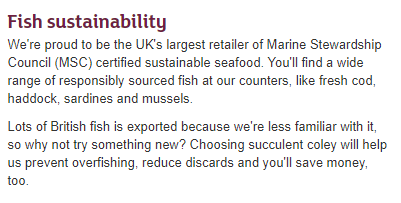We’ve all been there… the sheen of your weekly home prepared meals has worn off and you’re bored with your repertoire. You buy something different at the supermarket, perhaps a different type of fish, as you want to try and cook something new and spice up your evening meals. But what do you buy? Is it easy to cook or is there a chance you’ll ruin it and potentially waste your money?
This is, apparently, the mindset that many of us have and that denies us the luxury of preparing and tasting new foods and flavours. As a nation, we’re put off trying something new or different as we feel we don’t know how to prepare it, or don’t have the confidence.
At Marrfish we sell wholesale fish and seafood direct to trade which includes restaurants, hotels, pubs and colleges. The public has access to our fish via the menus of our clients, and we wish we could do more to promote and publicize underutilised fish species. The public must rely on supermarkets for their main sources of fish and seafood, and we are at the mercy of supermarket buying teams.
 A recent government survey has discovered that 24% of UK consumers would like to prepare and serve different types of fish at home but are unsure how to cook and prepare it.
A recent government survey has discovered that 24% of UK consumers would like to prepare and serve different types of fish at home but are unsure how to cook and prepare it.
Fish is a big part of our nation’s diet: –
• Under half of all UK consumers (42%) try to serve fish at home weekly
• 37% regard fish dishes as part of their meal repertoire
• 18% of consumers prefer prepared fish products, rather than cooking recipes from scratch
• 15% do not prepare or cook fish in the home but they do buy fish & chips
Seafood is also a big part of our diet but lacks consumer confidence to prepare it: –
• Only 25% of consumers would say seafood dishes are an established part of their meal repertoire
• 13% worry about not cooking it correctly or causing illness from undercooking
• 12% find it too time consuming and complex to prepare and cook at home
• 15% do not cook seafood at home at all, but do order it from takeaways or in restaurants
When out food shopping, 40% of UK consumers often repeat buy the same products over and over. 32% of us would like to try new species of fish and seafood products if they were available and easily visible on the shelf.
40% of consumers have no choice but to buy fish from the big supermarkets as they have no access to a fresh fishmonger.
This itself is worth thinking about. The supermarkets could be part of the issue. We’re reliant on what they buy in to sell to us, which is determined by profit. We can only buy fish if the supermarkets deem it worthwhile to sell to us – or at least that’s how it feels.
The findings of this survey appear to indicate more people would buy different species of fish if they were available for sale or were assured in how to prepare it. Around our coasts in the UK there are over 50 species of fish available. How many of those do you find in the supermarkets?
We recently did an online audit of supermarkets and these are the species you’ll find with ease on their websites (pre-packaged, fresh fish): –
| Asda | Tesco | Sainsbury | Morrison |
|---|---|---|---|
| Mackerel | Salmon | Cod | Salmon |
| Cod | Cod | Salmon | Cod |
| Salmon | Haddock | Haddock | Haddock |
| Tuna | Sea Bass | Prawns | Sea Bass |
| Haddock | Mackerel | Sea Bass | Mussels |
| Tuna | Prawns | Seafood Sticks | Razor Clams |
| Prawns | Basa | Mackerel | Prawns |
| Basa | Mussels | Sardines | Whitebait |
| Sea Bass | Roll Mops | Squid | Cockles |
| Plaice | Herring | Herring Roe | Mackerel |
| Roll Mops | Scallops | Hake | Crab Meat |
| Trout | Hake | Dover Sole | Eels |
| Mussels | Squid | Monkfish | Scallops |
| Seafood Sticks | Tuna | Anchovies | |
| Crab Meat | Trout | ||
| Jellied Eels | Roll Mops | ||
| Roll Mops | |||
| Lemon Sole | |||
| Basa | |||
| Trout | |||
| Mussels | |||
| Plaice | |||
| Sea Bream | |||
As you can see the supermarkets cater for the most popular fish, but there is a lack of diversity. This lack of choice means we, as consumers, cannot access other species. We cannot go and catch the fish ourselves, and most of us have no access to a fishmonger – so we are at the mercy of the supermarkets and their buying teams.
Out of the big four, surprisingly, Sainsbury offers the most choice of pre-packaged fresh fish.
All the supermarkets sold seafood sticks, however, which don’t contain any fish at all.
To be fair to Sainsbury, they had this message on their website, which mirrors perfectly what we are trying to achieve: –
 Having said that, where’s the Coley on your shelves Sainsbury? The message is right, spot on, but the execution stalled. It’s all very well spreading the word, but if a supermarket explains the situation above and doesn’t offer the solution, what’s the point in even saying anything at all?
Having said that, where’s the Coley on your shelves Sainsbury? The message is right, spot on, but the execution stalled. It’s all very well spreading the word, but if a supermarket explains the situation above and doesn’t offer the solution, what’s the point in even saying anything at all?
Market share of the big 4 supermarkets
We all have busy lives and we shop for convenience. There are not many people who could justify travelling miles out of their way to access a traditional fishmonger, therefor we have no choice but to rely on the supermarkets and their offerings. This has compounded the sustainability problem with fish as we’re all driven toward the same few species, whilst there are more species available, if they are not on the shelves the consumers cannot buy it.
Increased demand for Salmon, Cod and Haddock does nothing but increase prices – leading to a decrease in sales, the price lowers due to less demand, people buy fish again due to lower prices which increases demand, which raises prices. And so, it goes on.
The big four supermarkets have a massive market share: –
• Tesco – 27.8%
• Sainsbury – 15.8%
• Asda – 15.3%
• Morrison – 10.4%
This represents 69.3% of the UK market dominated by the “big 4”.
The rest of the market is made up of: –
• Co-op
• Waitrose
• Lidl
• Aldi
• Iceland
• + Independents
Our buying habits are determined by these big players, they are the biggest distributors in the country supplying some 29 million of us across Asda, Tesco, Sainbury and Morrison. They are the gatekeepers and it’s time they took some responsibility in utilising all our locally caught British fish. If there’s no demand, then they should create it. Make it easy for the consumer!
Variations on a theme
Oddly there were several variations on the same types of fish. This mainly affected salmon, where an example of one of the products available was fresh salmon on a lolly stick! Yes, a lolly stick, what use this comedic piece of fish has is questionable. In fact, it’s downright ridiculous.
We looked at all the fish available on supermarket websites and the amount of salmon on sale was worrying.
Tesco – 33% of the fish in their stores is salmon / 61% cod
Asda – 29% of the fish on sale is salmon / 15% cod
Morrison – 17% of fish on their website is salmon / 6% cod
Sainsbury – 22% of their fish was salmon / 7.3% cod
There’s a long way to go until the supermarkets get on board and properly promote sustainable and locally caught fish. By far the worst supermarket for diversity of species was Tesco. Just 6% of the fish sold was not salmon or cod and this causes increased and virtually unnecessary demand for those two fish. The result is that the consumer is charged more for their fish, due to forced demand, rather than being offered cheaper species which are every bit as tasty as the more popular fish.
Sustainable fishing is not just about eating less of a species – it’s about utilising the species we have on offer around us and this starts with the Supermarkets who should lead by example.

